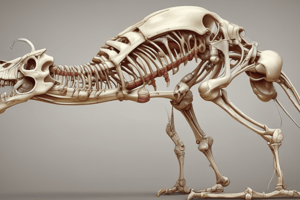Podcast
Questions and Answers
What is the soft, spongy interior of bones called?
What is the soft, spongy interior of bones called?
- Osteocytes
- Cortex
- Compact bone
- Trabecular bone (correct)
What is the primary storage site for calcium and phosphorus in the body?
What is the primary storage site for calcium and phosphorus in the body?
- Osteocytes
- Bone marrow (correct)
- Cortex
- Compact bone
Which cells are embedded in the mineralized matrix within the cortex of bones?
Which cells are embedded in the mineralized matrix within the cortex of bones?
- Compact bone
- Collagen fibers
- Osteocytes (correct)
- Hydroxyapatite crystals
What function do bones serve in protecting various organs?
What function do bones serve in protecting various organs?
Which part of bones is responsible for producing blood cells?
Which part of bones is responsible for producing blood cells?
What is the primary function of hematopoietic stem cells in the bone marrow?
What is the primary function of hematopoietic stem cells in the bone marrow?
Which cells are involved in bone remodeling by removing old bone tissue?
Which cells are involved in bone remodeling by removing old bone tissue?
What is a characteristic symptom of osteoporosis?
What is a characteristic symptom of osteoporosis?
Which disease results from a vitamin D or calcium deficiency in children?
Which disease results from a vitamin D or calcium deficiency in children?
What is the primary function of red bone marrow in bones?
What is the primary function of red bone marrow in bones?
Study Notes
Anatomy & Physiology: Skeletal System
Discovering the marvel of the human body's framework, we delve into the world of bones, bone structure, bone functions, and the processes that shape our skeletal system's health.
Bones
Our skeletal system is made up of around 206 bones, each playing a vital role in growth, support, and protection. An adult human skeleton contains 27 bones in the skull, 80 in the limbs, and 30 in the spine and chest. Bones are composed of a hard, dense outer layer called the compact bone, and a softer, spongy interior called the trabecular bone.
Bone Structure
Bones are not only rigid structures but also dynamic tissues that are constantly remodeling themselves. Each bone contains a core of bone marrow, where blood cells are produced, and a protective outer layer called the cortex. Within the cortex, bone cells called osteocytes are embedded in a mineralized matrix made of collagen fibers and hydroxyapatite crystals.
Bone Functions
Bones serve several essential functions in the human body:
- Support: Bones provide structural support and enable movement by connecting muscles and ligaments.
- Protection: Bones shield various organs and tissues, such as the brain, heart, and lungs.
- Mineral Storage: Bones are the primary storage site for calcium and phosphorus, which are essential for bone health, nerve function, and muscle contraction.
- Blood Cell Production: The bone marrow contains hematopoietic stem cells that produce all types of blood cells.
- Facilitate Movement: Bones contain hollow chambers that contain red bone marrow, which produces blood cells, and serve as passageways for blood vessels, nerves, and other tissues.
Bone Remodeling
Bone remodeling is a continuous process that involves the removal of old bone tissue (resorption) and the deposition of new bone tissue (formation). This process is regulated by osteoblasts (bone-building cells) and osteoclasts (bone-resorbing cells). Bone remodeling helps maintain bone strength and density, repair minor damage, and adapt to mechanical stress.
Skeletal System Diseases
Several conditions affect the skeletal system, including:
- Osteoporosis: A disorder characterized by low bone mass and increased risk of fractures.
- Osteoarthritis: A degenerative joint disease that causes pain, stiffness, and reduced mobility.
- Rickets: A childhood disorder resulting from a vitamin D or calcium deficiency, leading to weakened bones and delayed growth.
- Osteomyelitis: An infection of the bone tissue, often leading to severe pain, inflammation, and bone damage.
- Paget's disease: A condition characterized by excessive bone remodeling, leading to enlarged bones, pain, and the increased risk of fractures.
Understanding the structure and function of bones and our skeletal system provides a foundation for appreciating our body's remarkable capacity for growth, maintenance, and adaptation.
Studying That Suits You
Use AI to generate personalized quizzes and flashcards to suit your learning preferences.
Description
Test your knowledge of the human body's skeletal system, bone structure, bone functions, bone remodeling processes, common skeletal system diseases, and the importance of bone health and maintenance.




